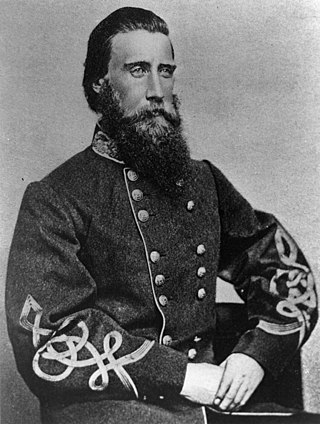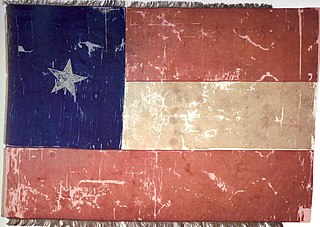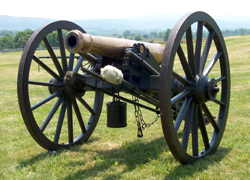
Matthew Duncan Ector was an American legislator, a Texas jurist, and a general in the Confederate States Army during the American Civil War.

The 4th Texas Infantry Regiment was a unit of Confederate States Army infantry volunteers that was created in 1861 and fought in the Army of Northern Virginia during the American Civil War. As part of the famous Texas Brigade, the regiment fought at Eltham's Landing, Seven Pines, Gaines's Mill, Second Bull Run, South Mountain, Antietam, and Fredericksburg in 1862. It fought at Suffolk, Gettysburg, Chickamauga and Wauhatchie in 1863 and the Wilderness, Spotsylvania, Cold Harbor, and the Siege of Petersburg in 1864. The regiment surrendered to Federal forces on 9 April 1865 after the Battle of Appomattox Court House.

The 5th Texas Infantry Regiment was a unit of Confederate States Army infantry volunteers created in 1861 that fought in the Army of Northern Virginia during the American Civil War. The unit was part of the famous Texas Brigade. The regiment fought at Eltham's Landing, Seven Pines, Gaines's Mill, Second Bull Run, South Mountain, Antietam, and Fredericksburg in 1862. It fought at Gettysburg and Chickamauga in 1863 and the Wilderness, Spotsylvania, Cold Harbor, and the Siege of Petersburg in 1864. The regiment surrendered to Federal forces on 9 April 1865 after the Battle of Appomattox Court House.

The 7th Texas Infantry Regiment was a unit of Confederate States Army infantry volunteers organized in 1861 that fought mostly in the Army of Tennessee during the American Civil War. The regiment was captured at Fort Donelson in 1862 and sent to Northern prison camps. After the survivors were exchanged and new recruits added, the regiment was reconstituted and fought at Raymond, Jackson, Chickamauga, Missionary Ridge, and Ringgold Gap in 1863. The unit served in the Atlanta Campaign and at Franklin, Nashville, Averasborough, and Bentonville in 1864–1865. The regiment's 65 survivors surrendered to William Tecumseh Sherman's Federal forces on 26 April 1865.

The 9th Texas Infantry Regiment was a unit of Confederate States Army infantry volunteers organized in December 1861 that fought during the American Civil War. The regiment fought at Shiloh, Perryville, and Stones River in 1862, Chickamauga in 1863, the Atlanta Campaign, Allatoona, and Nashville in 1864, and Spanish Fort and Fort Blakeley in 1865. The remaining 87 officers and men surrendered to Federal forces in May 1865. Two of the regiment's commanding officers were promoted brigadier general.

The 10th Texas Infantry Regiment was a unit of Confederate States Army infantry volunteers organized in October 1861 that fought during the American Civil War. The regiment was captured in its first major action at Arkansas Post in January 1863. After being exchanged three months later, the 10th Texas was consolidated with two other regiments and assigned to Patrick Cleburne's division. Subsequently, the consolidated regiment fought at Chickamauga, Missionary Ridge, and Ringgold Gap in 1863. After becoming an independent regiment again, the 10th Texas fought in the Atlanta Campaign, and at Franklin and Nashville in 1864. After a second consolidation the troops fought at Averasborough and Bentonville in 1865. The regiment's soldiers surrendered to Federal forces on 26 April 1865.

The 15th Texas Cavalry Regiment was a unit of cavalry volunteers mustered into the Confederate States Army in March 1862 and fought during the American Civil War. In July 1862 the unit was dismounted and served the remainder of the war as infantry. The regiment was captured at Arkansas Post in January 1863. After being exchanged three months later, the much-reduced 15th Texas was consolidated with two other regiments and assigned to Patrick Cleburne's division in the Army of Tennessee. The consolidated regiment fought at Chickamauga, Missionary Ridge, and Ringgold Gap in 1863. After a re-consolidation, the regiment fought in the Atlanta Campaign, and at Franklin and Nashville in 1864. After a final consolidation the troops fought at Averasborough and Bentonville in 1865. The regiment's 43 surviving soldiers surrendered to Federal forces on 26 April 1865.

The 32nd Texas Cavalry Regiment, sometimes incorrectly named Andrews's 15th Texas Cavalry Regiment, was a unit of volunteer cavalry mustered into the Confederate States Army in May 1862 and which fought during the American Civil War. The regiment was formed around companies from Richard Phillip Crump's 1st Texas Cavalry Battalion which fought in Indian Territory and at Pea Ridge. Many of the soldiers died of disease in the unhealthy camps near Corinth, Mississippi. The cavalrymen were dismounted in July 1862 and served as infantry for the rest of the war. The regiment fought at Richmond, Ky., Stones River, and Chickamauga in 1862–1863, in the Meridian and Atlanta campaigns and at Nashville in 1864, and at Spanish Fort and Fort Blakeley in 1865. The regiment's 58 surviving members surrendered to Federal forces on 9 May 1865.

Douglas's Texas Battery was an artillery battery that served in the Confederate States Army during the American Civil War. In June 1861, the unit was formed by combining one group of men from Dallas with a second group from Tyler and placing them under the command of John Jay Good. The battery fought at Pea Ridge in March 1862 and soon afterward transferred to the east side of the Mississippi River. James Postell Douglas replaced Good as commander and led the battery at Richmond, Stones River, Chickamauga, Chattanooga, the Atlanta Campaign, Franklin, and Nashville. After operations around Mobile, Alabama, Confederate units in the region surrendered and the survivors of the battery were paroled on 12 May 1865. It was the only Texas field artillery unit that served east of the Mississippi.

The 11th Texas Cavalry Regiment was a unit of mounted volunteers that fought in the Confederate States Army during the American Civil War. The regiment organized in October 1861 and fought at Chustenahlah against pro-Union Native Americans that winter and at Pea Ridge against Union troops in March 1862. The regiment dismounted to fight at First Corinth, Richmond, and Stones River in 1862. After being remounted, the 11th Texas Cavalry fought at Chickamauga, in Wheeler's October 1863 Raid, in the Atlanta campaign, in Sherman's March to the Sea, and in the Carolinas campaign. When the Confederate army surrendered in April 1865, its remaining soldiers dispersed.

The 10th Texas Cavalry Regiment was a unit of mounted volunteers in the Confederate States Army which fought during the American Civil War. The regiment mustered as cavalry in October 1861 but was dismounted in April 1862 and served as infantry for the rest of the war. The regiment was present at the Siege of Corinth, and fought at Richmond, Ky., Stones River, and Chickamauga in 1862–1863, in the Meridian and Atlanta campaigns and at Nashville in 1864, and at Spanish Fort and Fort Blakeley in 1865. The remaining 65 members of the regiment surrendered to Federal forces on 4 May 1865.

The 24th and 25th Consolidated Texas Cavalry Regiment was a unit that originally consisted of two regiments of mounted volunteers that served in the Confederate States Army during the American Civil War. However, by the time the two regiments were consolidated, they fought as infantry. Both regiments organized as cavalry near Hempstead, Texas in April 1862 and were dismounted to fight as infantry in July 1862. The two regiments served in the same brigade and were captured at the Battle of Arkansas Post in January 1863. After being sent to Northern prison camps, the soldiers were exchanged in April 1863. Assigned to the Army of Tennessee, the two regiments were consolidated with two additional Texas cavalry regiments and in 1863 fought as infantry at Liberty Gap, Chickamauga, Missionary Ridge, and Ringgold Gap. In 1864, the other two Texas regiments were detached and the consolidated 24th and 25th fought as a separate infantry unit in the Atlanta campaign, at Franklin, and at Nashville. For the Carolinas campaign, the 24th and 25th fought at Bentonville before being reconsolidated with other Texas regiments and surrendering in April 1865.

The 8th Indiana Cavalry Regiment was a cavalry regiment from Indiana that served in the Union Army during the American Civil War. The regiment mustered into service as the 39th Indiana Infantry Regiment on August 29, 1861, and fought at Shiloh and Stones River. After being converted to mounted infantry, the regiment served in the Tullahoma campaign and at Chickamauga. On October 15, 1863, the unit was renamed the 8th Indiana Cavalry and took part in Rousseau's Opelika Raid, and fought at Brown's Mill and Lovejoy's Station in the Atlanta campaign. The regiment served in Sherman's March to the Sea and the Carolinas campaign before being mustered out of service on July 20, 1865.

The 20th Louisiana Infantry Regiment was a unit of volunteers recruited in Louisiana that fought in the Confederate States Army during the American Civil War. The unit began its existence as the 6th Louisiana Battalion in September 1861. The battalion was augmented to regimental strength in January 1862 at New Orleans and served during the war in the Western Theater of the American Civil War. The regiment fought at Shiloh, Farmington, and Perryville in 1862. After being reduced in numbers, the regiment was consolidated with the 13th Louisiana Infantry Regiment and served at Stones River, Jackson, Chickamauga, and Missionary Ridge in 1863. The 13th-20th Consolidated Louisiana fought at Resaca, New Hope Church, Ezra Church, and Nashville in 1864. The consolidation with the 13th Louisiana was discontinued in February 1865 and the regiment was re-consolidated with other units. It fought its final battle at Spanish Fort one month before surrendering in May 1865.

The 13th Louisiana Infantry Regiment was a unit of volunteers recruited in Louisiana that fought in the Confederate States Army during the American Civil War. The unit was created when four infantry companies were added to the Battalion of Governor's Guards in September 1861. It served during the war in the Western Theater of the American Civil War. The regiment fought at Shiloh, Farmington, and Perryville in 1862. After being reduced in numbers, the regiment was consolidated with the 20th Louisiana Infantry Regiment and served at Stones River, Jackson, Chickamauga, and Missionary Ridge in 1863. The 13th-20th Louisiana fought at Resaca, New Hope Church, Ezra Church, and Nashville in 1864. The consolidation with the 20th Louisiana was discontinued in February 1865 and the regiment was re-consolidated with other units. It fought its final battle at Spanish Fort one month before surrendering in May 1865.

The 16th Louisiana Infantry Regiment was a unit of volunteers recruited in Louisiana that fought in the Confederate States Army during the American Civil War. The regiment organized in September 1861 and served during the war in the Western Theater of the American Civil War. The regiment fought at Shiloh, Corinth, and Perryville in 1862. In November 1862, the regiment was consolidated with the 25th Louisiana Infantry Regiment and served at Stones River, Jackson, Chickamauga, and Missionary Ridge in 1863. The unit fought at Resaca, New Hope Church, Atlanta, Ezra Church, Jonesborough, and Nashville in 1864. The consolidation with the 25th Louisiana was discontinued in February 1865 and the regiment was re-consolidated with the 1st Louisiana Regulars and 20th Louisiana Infantry Regiments. The unit fought its final battle at Spanish Fort. The regiment was again consolidated into the Chalmette Regiment shortly before surrendering in May 1865.
The 25th Louisiana Infantry Regiment was a unit of volunteers recruited in Louisiana that fought in the Confederate States Army during the American Civil War. The regiment organized in March 1862 at New Orleans and served during the war in the Western Theater of the American Civil War. The regiment served at First Corinth and Perryville in 1862. In November 1862, the regiment was consolidated with the 16th Louisiana Infantry Regiment and served at Stones River, Jackson, Chickamauga, and Missionary Ridge in 1863. The 16th-25th Consolidated Louisiana Infantry fought at Mill Creek Gap, Resaca, New Hope Church, Atlanta, Ezra Church, Jonesborough, and Nashville in 1864. The consolidation with the 16th Louisiana was discontinued in February 1865 and the regiment was re-consolidated with the 4th Louisiana Infantry Battalion. The new unit fought its last battle at Spanish Fort. The unit again re-consolidated, becoming two companies of the Pelican Regiment before surrendering in May 1865.

The 13th and 20th Consolidated Louisiana Infantry Regiment was a unit of volunteers recruited in Louisiana that fought in the Confederate States Army during the American Civil War. It served only in the Western Theater. The unit was created in November 1862 by combining the veteran but diminished 13th Louisiana and 20th Louisiana Infantry Regiments to form the consolidated regiment. The regiment fought at Stones River, Jackson, Chickamauga, and Missionary Ridge in 1863. The 13th-20th Louisiana fought at Resaca, New Hope Church, Ezra Church, Jonesborough, and Nashville in 1864. The consolidation was discontinued in February 1865 and the 13th and 20th Infantry Regiments were re-consolidated with other units.

The 16th and 25th Consolidated Louisiana Infantry Regiment was a unit of volunteers recruited in Louisiana that fought in the Confederate States Army during the American Civil War. It served only in the Western Theater. The unit was created in November 1862 by combining the veteran 16th Louisiana and 25th Louisiana Infantry Regiments to form the consolidated regiment. The new unit served at Stones River, Jackson, Chickamauga, and Missionary Ridge in 1863. The unit fought at Resaca, New Hope Church, Atlanta, Ezra Church, Jonesborough, and Nashville in 1864. The consolidation was dissolved in February 1865 and the 16th and 25th Infantry Regiments were re-consolidated with other units

The 4th Louisiana Infantry Battalion was an infantry unit recruited from Louisiana volunteers that fought in the Confederate States Army during the American Civil War. The unit organized as a battalion in July 1861 and initially served as prison guards. In November the battalion served briefly in the Western Virginia campaign. From 1862 to Spring 1863 the battalion guarded Savannah, Georgia, Charleston, South Carolina, and Wilmington, North Carolina, fighting at Secessionville in June 1862. The unit traveled west where it fought at Jackson, Chickamauga, and Missionary Ridge in 1863. The battalion fought in the Atlanta campaign in 1864. Assigned to defend Mobile, Alabama, the battalion fought at Spanish Fort in April 1865. One month later, the remnant of the unit surrendered.



















